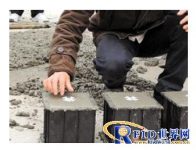
NCDOT deploys RFID technology to achieve effective traceability of precast concrete
[ad_1]
The North Carolina Department of Transportation is deploying RFID technology, and the system is currently in the testing phase. The system can realize precast concrete inspection and realize automatic management. The solution, provided by International Coding Technology (ICT), allows government agencies to better inspect and manage infrastructure construction engineering materials.So far, two manufacturers have used this technology and sharedRFIDPrecast concrete data collected by the reader: Cherry Precast and Concrete Pipe & Precast. At the same time, they also achieved visibility into inventory management and inspection processes.

Typically, precast concrete items are produced by the manufacturer and tested by NCDOT. After passing the test, these products can be used on railways and other projects. In the past, to help government agencies trace these items, manufacturers were required to put unique stamped identifiers (visible on the date of manufacture) on these items. After the test is passed, the inspector is also required to mark an additional stamped identifier. These flag ID codes will also be entered on the electronic system residing in NCDOT’s database.
Randy Pace, a materials business engineer at NCDOT, said the manual traceability method had many flaws. Inkjet printers are time-consuming and error-prone. Since the inspection process is preceded by data input, the inspection personnel do not know the inspection and delivery time, so employees need to spend additional time searching for product information. At the same time, the government is also laying off staff, with 17 fewer testing staff now than in 2008. Therefore, NCDOT needs to improve efficiency.
Around 1998, NCDOT deployed the Highway Construction and Management System (HiCAMS) to monitor government building materials and related inspections. The HiCAMS website is managed by government departments, and manufacturers can log in with a password to view project-related information. However, these data all require human input into the system.
So NCDOT set out to find an automated way to populate the data and considered using QR code tags to track these items. At that time, due to price factors, the plan did not pass. Also, QR code tags are used in precast concrete, they can only be used after the concrete has set.
NCDOT started looking for an RFID solution in 2011, Pace said. It turned out that IDT’s Idencia tags (passive UHF RFID inlays from Shanghai Boeing) were housed within a sturdy plastic protective film. The reading size of the label is 1.5*4.5 inches, and the QR code ID number is printed on the front, which is specially designed for the precast concrete pouring process.
The solution includes an Idencia label and cloud management software. It has been tested in 5 precast concrete manufacturing companies in the past two years. During this trial, NCDOT and ICT marked a total of 13,000 products in the pouring process and read them with a handheld reader. Ultimately, the two manufacturers chose Idencia’s solution, Pace said.
In May, NCDOT started using the system to enable sample tracking of concrete inside roads and bridges. Material samples such as concrete test cylinders, soil samples, steel bars, asphalt, etc. on these projects are usually marked on the construction site, and then transported to the laboratory for testing and tracking. Workers place Idencia labels in sample packs or affix them on site. In this way, it is guaranteed that every sample can be traced back.
“Now, we don’t need to fill out cards manually anymore,” Pace said. “All data is automatically entered into the HiCAMS system.” Lab workers use RFIDReaderRead RFID tags with built-in sample origin, material details and other information. After the test is completed, the staff can also enter test-related information.
Before the pouring process, the manufacturer needs to enter the built-in product model, date, location and other information into the QR code or RFID tag. In addition, during the production process, the staff also needs to enter the information of the reinforcement, concrete spacing and size.
After the pouring process is completed, the label information will be uploaded to the cloud system. The inspector can log into the Idencia system at any time to view the relevant project schedule and best test preparation. In this way, inspectors can go to the scene to take samples in time.
The inspector brought an Android mobile phone and a battery-driven ATID AT288 Bluetooth handheld UHF reader to the scene. When the worker walks to the edge of the precast concrete, the reader captures the tag ID number and transmits it to the phone via Bluetooth. After the detection, the staff can update the information on the mobile phone and upload it to the server. In addition, these data should be stored on the HiCAMS software at the same time.
Pace said they haven’t calculated the benefits of the system, but he expects the system to save $1.2 million a year. He also put in the associated costs, $19,000 for the software, $2,400 for the six readers, 85 cents per tag.
(The exclusive manuscript of rfid world network, please indicate the source author for reprinting!)
[ad_2]



